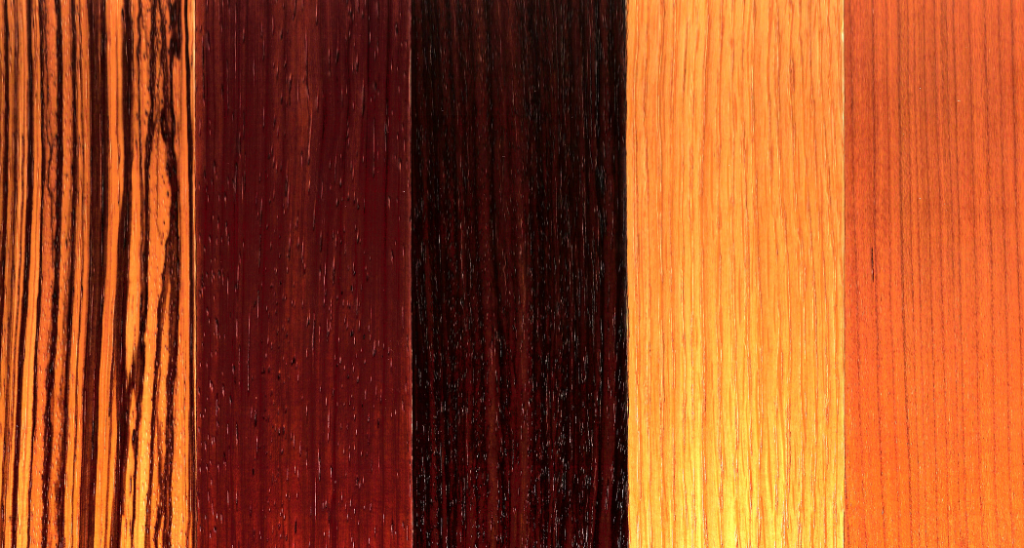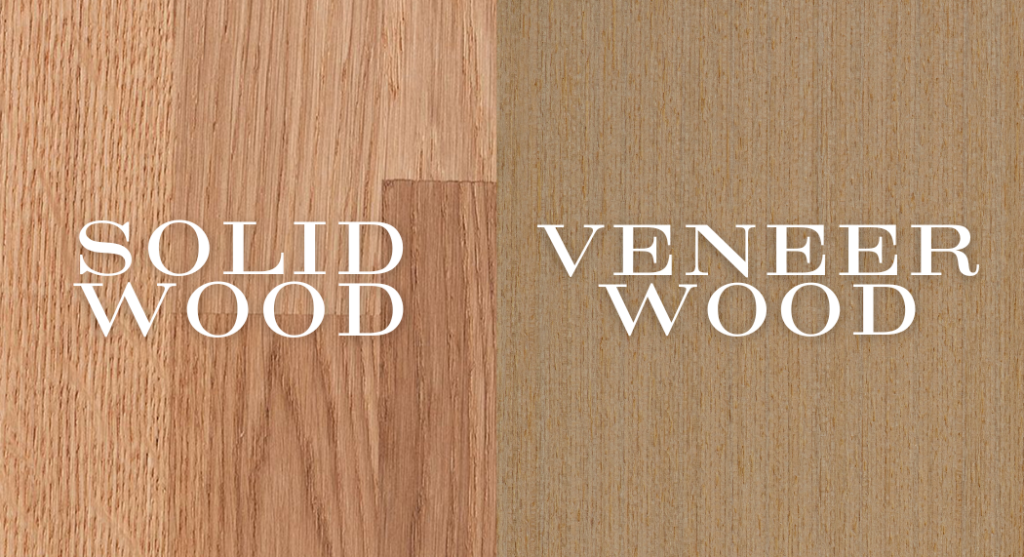
Making a Choice – Solid Wood vs Veneer Furniture
Kicking Off Your Furniture Journey: Solid Wood vs Veneer Insights
When it comes to furnishing a home, the choice between solid wood and veneer furniture is a significant one that homeowners often face. This decision not only impacts the aesthetic appeal of a space but also affects the durability, maintenance, and overall investment in home decor.
Solid wood furniture, revered for its strength and timeless beauty, stands against veneer furniture, known for its affordability and versatility. Understanding the differences between these materials is crucial for anyone looking to make an informed choice that aligns with their style, functional needs, and budget constraints. In this blog, we delve into the solid wood versus veneer furniture debate, offering insights into the pros and cons of each to help you decide which is best for your home.

Solid Wood Furniture: Durability Meets Elegance
Solid wood furniture is exactly what its name suggests: furniture made entirely from natural wood. This category of furniture is highly sought after for its robustness and the unique character it brings to living spaces, with each piece featuring distinct grain patterns and textures. One of the main advantages of choosing solid wood is its durability. Furniture crafted from solid wood is built to last, often becoming heirloom pieces passed down through generations. Additionally, the longevity of solid wood furniture is unparalleled, with the option to sand and refinish surfaces to address wear or update the style.
However, solid wood furniture comes with its set of challenges. The cost is a significant factor, as the quality and craftsmanship of solid wood pieces often come with a higher price tag compared to their veneer counterparts. Furthermore, solid wood is susceptible to environmental changes; it can expand or contract in response to fluctuations in humidity and temperature, which may lead to warping or cracking over time. These potential drawbacks are important to consider when choosing solid wood for your furniture needs.

Veneer Furniture: Affordable Elegance for Modern Homes
Veneer furniture uses thin wood layers glued onto a core panel, like plywood or MDF. This method highlights the wood’s natural beauty while being resource-efficient. It involves slicing wood sheets and placing them over a sturdy core. This showcases the wood’s look on visible parts while keeping the structure solid.

Veneer furniture’s benefits include its affordability. It lets people enjoy the look of costly wood without the high price of solid wood. It also comes in many finishes and styles, using less wood for a range of designs. Veneer offers more stability than solid wood, as its base resists the wood’s expansion and contraction due to humidity changes. This means less warping or splitting.
Yet, there are factors to consider with veneer furniture. It might not last as long as solid wood with intense use. The surface can get scratches, chips, or peel, especially if the veneer is thin or the furniture’s quality is low. Repairing these damages can be tough, with deep scratches being hard to fix. Anyone thinking about veneer furniture should consider these points to ensure their choice meets their needs and lasts.

Comparative Analysis: Solid Wood vs Veneer
| Feature | Solid Wood Furniture | Veneer Furniture |
| Appearance | Natural beauty with unique grain patterns and rich texture. | Wide variety of appearances due to different wood types and finishes. |
| Cost | Higher price, reflecting quality and durability. | More affordable, offering high-end looks without the high price. |
| Maintenance | More intensive; requires regular treatment to protect against environmental changes. | Somewhat simpler, but can be prone to chipping and peeling. |
| Lifespan | Extensive, often lasting decades or generations with proper care. | Substantial, but typically does not match the longevity of solid wood. |
Situational Recommendations:
- Choose Solid Wood when looking for longevity, the ability to refinish, and if the investment aligns with your budget. Ideal for heirloom pieces and environments where the furniture will be a central focus of the room.
- Opt for Veneer for more affordable options, a wider variety of styles, and when purchasing pieces that may be replaced or updated more frequently. Suitable for trend-following decor or when budget constraints are tighter.

Environmental Impact and Sustainability
The environmental impact of furniture materials is an important consideration for many consumers today. Solid wood furniture, while durable and long-lasting, requires the use of mature trees, which can impact deforestation rates. However, sustainably sourced wood, certified by organisations such as the Forest Stewardship Council (FSC), offers a more environmentally friendly option by ensuring that wood is harvested responsibly.
Veneer furniture, on the other hand, makes more efficient use of wood by utilising thin slices applied to a core, reducing the amount of solid wood needed for each piece. This can potentially lower the impact on forests, but it’s important to consider the type of core material used and the sustainability of the wood sources for veneers.

When prioritising environmental sustainability, look for furniture—whether solid wood or veneer—that uses sustainably sourced materials and adheres to eco-friendly manufacturing processes. Checking for certifications and the company’s sustainability practices can guide responsible furniture choices that align with environmental values.
Expert Care Tips for Solid Wood and Veneer Furniture
Solid Wood Furniture:
- Dust Regularly: Use a soft, dry cloth to remove dust and prevent build-up that can scratch the surface.
- Protect from Environmental Changes: Avoid placing solid wood furniture near heat sources or in direct sunlight to minimise warping or fading. Consider using a humidifier in dry climates to prevent cracking.
- Clean Spills Immediately: Wipe up any spills quickly to prevent water marks or damage to the finish.
- Use Proper Cleaning Products: Opt for wood-specific cleaners and avoid harsh chemicals that can strip the finish.
- Refinish as Needed: Solid wood can be sanded and refinished to repair wear or update its appearance.
Veneer Furniture:
- Gentle Cleaning: Dust with a soft cloth and use a mild soap and water solution for stains, avoiding excessive moisture.
- Avoid Sharp Objects: Prevent scratches and chips by using coasters and placemats, and avoid dragging items across the surface.
- Protect the Surface: Use protective pads under lamps and decor to prevent scratches and dents.
- Repair Minor Damage: Small chips or peeling can often be glued back in place, but consult a professional for best results.
- Avoid Heat and Moisture: Keep veneer furniture away from radiators, stoves, and direct sunlight to prevent warping or lifting.

Making the Right Choice for Your Home
When deciding between solid wood and veneer furniture, consider the following factors:
- Budget: Solid wood typically comes with a higher initial cost but can be a worthwhile investment due to its longevity. Veneer offers a cost-effective alternative with a similar aesthetic.
- Style Preferences: Consider the look you want to achieve. Solid wood adds timeless elegance, while veneer can provide a wider range of finishes and styles.
- Intended Use: Evaluate how the bedroom furniture will be used. For high-traffic areas or pieces that will see heavy use, solid wood may be more durable. For decorative pieces or where budget constraints exist, a veneer could be sufficient.
- Quality Assessment: Inspect the craftsmanship, joinery, and finish of the furniture. Solid wood should feel sturdy and free of major defects, while veneer should have well-adhered layers without bubbling or peeling.
- Personal Values and Practical Considerations: Reflect on your long-term needs and the environmental impact of your choice. Sustainability-sourced solid wood or veneer can align with eco-friendly values.

Embracing Your Furniture Choice with Confidence and Style
Choosing between solid wood and veneer furniture requires careful thought. Consider cost, durability, maintenance, and style. Both options have unique benefits. It’s vital to pick what matches your lifestyle and decor aims. Understanding each type’s features and care needs helps in making a wise choice. This ensures long-term satisfaction and enjoyment of your furniture. Let this guide encourage you to think about both function and design in furniture choice. This way, you can craft a home that mirrors your style and fulfils your needs.

Frequently Asked Questions
Veneer furniture, while offering a stylish and affordable option, does come with some downsides. The primary disadvantage is its susceptibility to damage such as scratches, chips, and peeling, especially if the veneer layer is thin or the furniture piece is not of high quality. This can be a concern for high-traffic areas in your home. Repairing veneer damage can be challenging and often limits the furniture’s lifespan compared to solid wood pieces. Additionally, exposure to moisture can cause the veneer to warp or detach, making it less suitable for humid environments.
Veneer furniture, while offering a stylish and affordable option, does come with some downsides. The primary disadvantage is its susceptibility to damage such as scratches, chips, and peeling, especially if the veneer layer is thin or the furniture piece is not of high quality. This can be a concern for high-traffic areas in your home. Repairing veneer damage can be challenging and often limits the furniture’s lifespan compared to solid wood pieces. Additionally, exposure to moisture can cause the veneer to warp or detach, making it less suitable for humid environments.
Veneer furniture, while offering a stylish and affordable option, does come with some downsides. The primary disadvantage is its susceptibility to damage such as scratches, chips, and peeling, especially if the veneer layer is thin or the furniture piece is not of high quality. This can be a concern for high-traffic areas in your home. Repairing veneer damage can be challenging and often limits the furniture’s lifespan compared to solid wood pieces. Additionally, exposure to moisture can cause the veneer to warp or detach, making it less suitable for humid environments.
Veneer furniture, while offering a stylish and affordable option, does come with some downsides. The primary disadvantage is its susceptibility to damage such as scratches, chips, and peeling, especially if the veneer layer is thin or the furniture piece is not of high quality. This can be a concern for high-traffic areas in your home. Repairing veneer damage can be challenging and often limits the furniture’s lifespan compared to solid wood pieces. Additionally, exposure to moisture can cause the veneer to warp or detach, making it less suitable for humid environments.
Veneer furniture, while offering a stylish and affordable option, does come with some downsides. The primary disadvantage is its susceptibility to damage such as scratches, chips, and peeling, especially if the veneer layer is thin or the furniture piece is not of high quality. This can be a concern for high-traffic areas in your home. Repairing veneer damage can be challenging and often limits the furniture’s lifespan compared to solid wood pieces. Additionally, exposure to moisture can cause the veneer to warp or detach, making it less suitable for humid environments.
